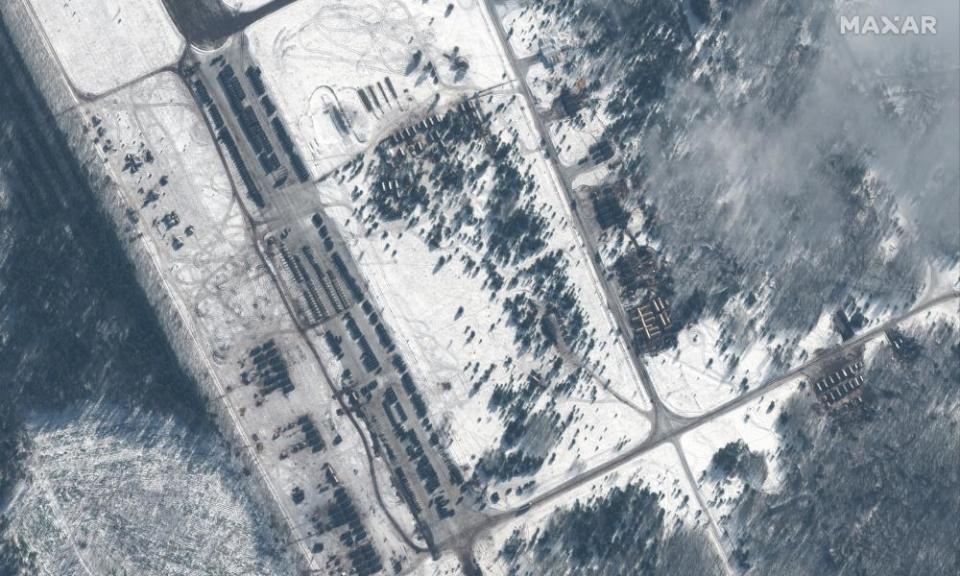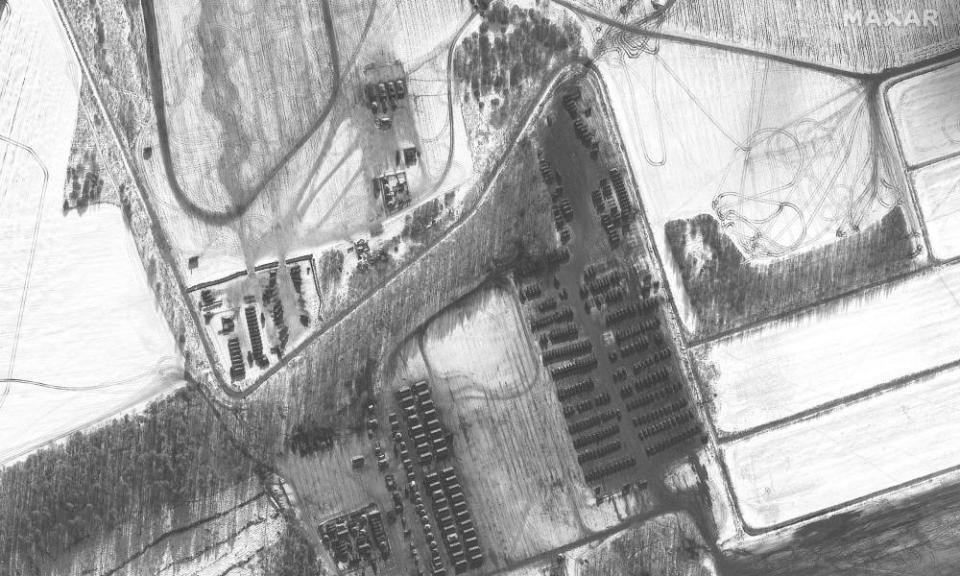Russia-Ukraine crisis: where are Putin’s troops and what are his options?

A visual guide to recent troop deployments as tensions soar
Why are there tensions?
American officials have warned of the “very distinct possibility” of a Russian invasion of Ukraine in the next few days, after Russia forward-deployed hundreds of tanks, self-propelled artillery and even short-range ballistic missiles from as far away as Siberia to within striking range.
Moscow’s rhetoric has also grown more belligerent. Vladimir Putin has demanded legal guarantees that Ukraine will never join Nato or host its missile strike systems, concessions he is unlikely to receive. A flurry of diplomatic activity has done little to ease tensions.
Putin is also short on time. His troops cannot remain out of garrison indefinitely. By late winter he will probably have to launch an attack or draw down his forces, in what would look like a retreat. In the meantime the UK, US and others have to told their citizens to leave.
What do we know about the deployments?
As of 13 February, 93 battalion tactical groups, the smallest operational unit in Moscow’s army, of around 800-1,000 troops, were estimated by military intelligence group Rochan Consulting to be in place near the borders of Ukraine in both Russia and latterly Belarus. The UK estimates the figure is higher, at 100, with 14 more due to arrive.
Many of the heavy weapons stationed near Ukraine arrived in spring 2021, when Russia put an estimated 110,000 troops with tanks and other heavy weaponry near the border. Some, but not all, of Russia’s troops to base in May after Putin secured a summit with Joe Biden.
But Russian troops have been coming from the east for weeks. On 11 February, the head of the Norwegian intelligence service said they numbered 150,000. There are also separatist forces in the breakaway areas of Donetsk and Luhansk. Their numbers are estimated at 32,000, some are likely to be unacknowledged Russian forces.
Half of Russia’s airforce is also now deployed near Ukraine, according to Western estimates, while more than 30 Russian warships started training exercises in the Black Sea on Sunday.
This assessment shows some of the main deployments as of late 2021:
In early February, there was some evidence that forces previously massed several hundred miles from the border were moving closer to Ukraine. There were signs that the seven BTGs stations in Yelnya, near Smolensk, were moving on to near Klintsy, about 100km from the border.
Over the new year Russia began to move tanks, artillery, air-defence systems and fighter jets to Belarus for joint “Allied Resolve” exercises that started on 10 February and are due to run until 20 February. That deployment has grown and is currently estimated at about 25 BTGs or possibly higher.

Nato has warned that Russian forces in Belarus could reach 30,000, including Speznaz special operations forces, SU-35 fighter jets, S-400 air defence systems and Iskander missiles, which can carry nuclear weapons, and have a range of 500km.

One of the largest forces to remain near Ukraine since May 2021 comes from the 41st Combined Arms Army, which is headquartered in Novosibirsk almost 2,000 miles away. Stationed at the Pogonovo training area south of Voronezh since spring, some of the 41st CAA forces have moved to Yelnya, a town in the Smolensk region closer to Belarus.
The equipment includes motorised infantry, main battle tanks, rocket artillery and Iskander short-range ballistic missiles comprising an estimated six or seven BTGs, according to an estimate by the independent defence analyst Konrad Muzyka.
Satellite images taken from above Pogonovo depict the arrival of more equipment between November 2021 and January 2022.
Other recent movements show motor rifle brigades from the 49th Combined Arms Army moving towards Crimea. Artillery and air-defence assets from the 58th Combined Arms Army have also been spotted in satellite photographs taken from above Novoozerne in western Crimea. The US estimates 10,000 troops moved into Crimea in late January and early February.
There are also units permanently deployed near Ukraine from the 8th and 20th Combined Arms Armies.
What form could a Russian attack take?
An invasion would take place on multiple axes, with Russian forces expected to try and encircle Ukraine’s military in the east of the country, but Western intelligence agencies believe that the most likely goal of a Russian offensive would be to surround Kyiv and force regime change. They concluded that as of 11 February Putin had put in place enough troops to attempt an invasion.
The US, the UK and some independent western experts highlight the importance of Belarus in an offensive on Kyiv. The country, now closely aligned to Moscow, is considered the simplest invasion route to Ukraine’s capital as it would allow Russian forces to cross the large Dniepr river in friendly territory and attack from the west.
This runs counter to the thinking in Ukraine as of late January that a focused attack in the east was the most likely scenario. On 21 January Ukrainian military intelligence said that since the beginning of the month Moscow had supplied separatists in eastern Ukraine with additional tanks, self-propelled artillery, mortars and more than 7,000 tons of fuel.
A map released by Ukrainian military intelligence in November showed a worst-case scenario: Russian forces crossing the Ukrainian border from the east and attacking from annexed Crimea, as well as launching an amphibious assault on Odessa with support from Russian soldiers in Transnistria and troops sent in from Belarus.
The potential economic consequences of any new fighting would be enormous as the US and its allies are promising “significant and severe” economic and technological sanctions in the event of an attack, while Russia could cut off gas supplies to Europe.
Russia could still seek concessions from the west in negotiations while maintaining its troops along the border for a credible threat of escalation. Putin has said he believes high tensions are useful for Russia. Nevertheless, some analysts say that without a clear diplomatic victory, any drawdown could look like a defeat.
When might an attack happen?
February has long been seen as the most likely month for a potential offensive. Russian soldiers are participating in military exercises in Belarus which are due to finish on 20 February and Vladimir Putin has returned from a trip to Beijing for the Winter Olympics opening ceremony.
How did we get here?
In 2014 Putin sent troops to annex Crimea, a mainly Russian-speaking region of Ukraine. Russia also incited a separatist uprising in Ukraine’s south-east, clandestinely sending soldiers and weapons to provoke a conflict that grew into a full-blown war.
A 2015 peace deal established a line of demarcation and called on both sides to make concessions. Since then low-level fighting has continued along the front, and both sides have accused the other of violating the agreement, which observers say is close to collapse.
Russia no longer wants to maintain the status quo and is looking for another way to assert control over Ukraine.
What is the role of Nord Stream 2?
The completion of the Nord Stream 2 gas pipeline from Russia to Germany via the Baltic Sea gives both sides an economic weapon.
The pipeline would allow Russia to send gas to Europe without going through Ukraine, meaning Moscow could pile pressure on Kyiv without the risk that Kyiv would cut the gas supply route in retaliation. Ukraine has lobbied furiously against the project, saying it undermines its national security.
However, the pipeline, which has become a pet project of Putin’s, has not yet come online, and western governments have indicated that in the case of invasion, that may never happen.

 Yahoo News
Yahoo News 
